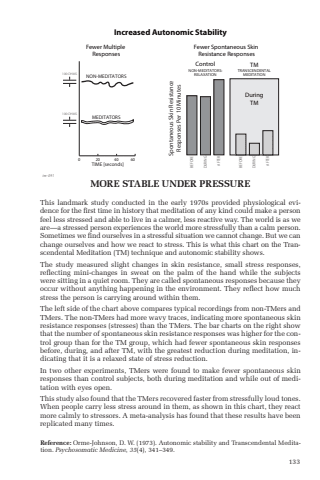Page 135 - Demo
P. 135
133This landmark study conducted in the early 1970s provided physiological evidence for the fi rst time in history that meditation of any kind could make a person feel less stressed and able to live in a calmer, less reactive way. The world is as we are %u2014 a stressed person experiences the world more stressfully than a calm person. Sometimes we fi nd ourselves in a stressful situation we cannot change. But we can change ourselves and how we react to stress. This is what this chart on the Transcendental Meditation (TM) technique and autonomic stability shows. The study measured slight changes in skin resistance, small stress responses, refl ecting mini-changes in sweat on the palm of the hand while the subjects were sitting in a quiet room. They are called spontaneous responses because they occur without anything happening in the environment. They refl ect how much stress the person is carrying around within them. The left side of the chart above compares typical recordings from non-TMers and TMers. The non-TMers had more wavy traces, indicating more spontaneous skin resistance responses (stresses) than the TMers. The bar charts on the right show that the number of spontaneous skin resistance responses was higher for the control group than for the TM group, which had fewer spontaneous skin responses before, during, and after TM, with the greatest reduction during meditation, indicating that it is a relaxed state of stress reduction.In two other experiments, TMers were found to make fewer spontaneous skin responses than control subjects, both during meditation and while out of meditation with eyes open. This study also found that the TMers recovered faster from stressfully loud tones. When people carry less stress around in them, as shown in this chart, they react more calmly to stressors. A meta-analysis has found that these results have been replicated many times.Increased Autonomic StabilityControl TMFewer Spontaneous SkinResistance ResponsesSpontaneous Skin ResistanceResponses Per 10 MinutesFewer MultipleResponses100 OHMS100 OHMSNON-MEDITATORSMEDITATORSTIME [seconds]0 20 40 60NON-MEDITATORS:RELAXATIONTRANSCENDENTALMEDITATIONDuringTMBEFORE DURING AFTER BEFORE DURING AFTERtm-091MORE STABLE UNDER PRESSUREReference: Orme-Johnson, D. W. (1973). Autonomic stability and Transcendental Meditation. Psychosomatic Medicine, 35(4), 341%u2013349.


